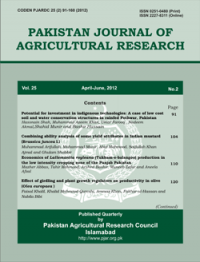EVALUATION OF MULCHING MATERIALS AS INTEGRATED WEED MANAGEMENT COMPONENT IN MAIZE CROP
Farman Ullah Shah*, G. Mustafa Sajid** and Sadar Uddin Siddiqui**
ABSTRACT
Yield losses by weeds in maize crop and demonstrated efficacy of various mulches in weed management led to check the efficacy of various available mulches for suppressing weeds in maize crop at National Agricultural Research Centre (NARC), Islamabad during kharif (autumn) season 2011. The experiment was laid in Randomized Complete Block Design, (RBCD) having eight treatments and four replications. The treatments were black plastic, white plastic, sugarcane straw, wheat straw, live mulch, weeds as mulch, hand weeding and weedy check. Weed data -2 -2 included weed density m , fresh and dry weight g m , while crop data -2 -2 -1 included crop density m , fresh and dry weight g m , number of plant plot , -1 stover yield (g), plant height (cm), number of cobs plant , number of leaves -1 -1 plant , average grain number of five cobs and grain yield (t ha ). With the -2 -2 exception of hand weeding, minimum number of weeds 128 m and 164 m were recorded in black plastic and weeds as mulch, respectively, compared -2 to 595 m in weedy check. Similarly, maximum grain yields (1.91 and 1.85 -1 t ha ) were recorded in black plastic and weeds as mulch, while minimum -1 grain yield (0.64 t ha ) was recorded in weedy check plots. The economic net returns of black plastic mulch and weeds as mulch were Rs. 39,824 and Rs. 38,291, respectively as compared to Rs. 21431 for weedy check. Yield increased by 21.1 and 16.5% over hand weeding by plastic mulch and weeds as mulch, respectively. Black plastic followed by weeds as mulch, are recommended to control weeds and get maximum yield as well as net economic return.
To share on other social networks, click on any share button. What are these?






